Jump To: History of Indian Head Cents | Composition | The Flying Eagle Penny | Indian Head Cent Design | Indian Head Pennies Price Chart | Most Valuable
Indian head pennies are almost as old as the United States. The U.S. Mint, established in 1792, has a rich history of producing coins for circulation within the United States. While it did engage in producing coins for other countries in the past, since 1984, the U.S. Mint has focused exclusively on striking coins for the United States.
This history showcases valuable lessons on the creation of iconic and historically significant coinage.
In fact, the cents were their first circulating coins ever released. Since then, many different designs have stamped the faces of the beloved penny. The Indian Head Penny, as you will see further in this article, is a great example. It is one of the most popular designs in the series of small cents between numismatics and coin collectors.
History of the Indian Head Cent
The United States Mint first introduced the one-cent coin in 1793, along with the half-cent coin, produced by their newly established refinery in Philadelphia. That first coin, with a face value of 1 cent, was made of pure copper and had a diameter of 1⅛ inch (22.57 mm). It was almost the size of a half-dollar coin, and they came to be known as the large cents.
Between 1792 and 1862, the United States accepted only gold and silver as legal tender. In the late 1840s and early 1850s, the discovery of gold in California led to an inflation in other precious metals, including copper. For instance, the Mint director James Ross Snowden noted through his annual report that the cost of producing copper coins like the half-cent and large cents was not compensating for the expenses due to the value of copper.
This was not the first nor the last time the price inflation for copper led to a change in the one-cent coin composition. In 1943, driven by the copper demand in the World War II efforts, the US Mint produced steel cents for one year. That alloy change caused one of the rarest and most expensive transitional error coins in US history, the 1943 Copper Penny.
Composition
In 1857, though, with the increased production costs for the cent and the half-cent, the US Mint rushed to look for alternatives and discontinued the half-cent altogether. They also changed the composition of the one-cent coin to 12% nickel and 88% copper and reduced its size to 0.750 inches (19.05 mm). The diameter is still used nowadays for the denomination, although current pennies are slightly thinner.
In addition, a new design was issued for circulation in 1857, the Flying Eagle cent. Philadelphia Minting Chief Engraver James B. Longacre created the depiction. He based the eagle in flight design on his predecessor's work, Christian Gobrecht. The reverse of the new pattern coin featured the denomination encircled by a wreath.
See what pennies are made of nowadays.
The Flying Eagle Penny
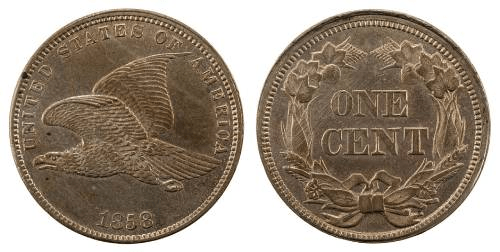
The nickel composition made the coins look brighter than the previous issue. For that reason, people called it the “White cent” or “Nicks.”
The Flying Eagle Penny was produced in limited numbers as a pattern coin in 1856, then for circulation in 1857 and 1858. Until then, only a large cent coin was in circulation. However, production difficulties forced the Mint to replace them in 1859 quickly. Longacre was, again, the designer for the new coin, which received the moniker of Indian Head Penny.
The Indian Head Cent Design
The new obverse featured the goddess Liberty wearing a native american headdress. The words “UNITED STATES OF AMERICA” encircle the portrait, with the mint year below. A numismatic tale suggests that the facial features of Lady Liberty wearing the feathered tiara were based on Longacre's daughter.
The coin's visuals can be controversial for a few reasons. First, the obverse design shows a Caucasian woman wearing an Indian headdress reserved for only native american men who must have earned a place of respect within their tribe. But beyond the historical inaccuracy, the Indian head pennies were issued when the native americans had to leave their ancestors' lands. A background that can suggest some tactlessness towards the Native American past.
However, the artist responsible for the coin's design justified his artistic choices:
"From the copper shores of Lake Superior to the silver mountains of Potosi, from the Ojibwa to the Aramanian, the feathered tiara is as characteristic of the primitive races of our hemisphere as the turban is of the Asiatic. Nor is there anything in its decorative character, repulsive to the association of Liberty … It is more appropriate than the Phrygian cap, the emblem rather of the emancipated slave than of the independent freeman, of those who are able to say “we were never in bondage to any man.”
I regard then this emblem of America as a proper and well-defined portion of our national inheritance, and having now the opportunity of consecrating it as a memorial of Liberty, ‘our Liberty,' American Liberty; why not use it? One more graceful thing can scarcely be devised. We have only to determine that it shall be appropriate, and all the world outside of us cannot wrest it from us."
The reverse showed a similar laurel leaf wreath with the denomination on the center, as it had been used for the Flying Eagle design. The wreath was changed to an oak wreath with a shield in 1860.
Along with this change, the artist added a presidential seal to the top of the coin.
The Indian Head Cent had its highest mintage in 1907, when 108,138,618 pieces were struck. It was the only issue of the Indian Head Penny series, whose production surpassed 100 million units. The series with the lowest pieces of Indian head pennies is from 1877 and 1909.
Indian Head Pennies were produced both in the San Francisco and Philadelphia Mint branches. These last ones carry a mint mark, the letter “S” on the reverse, below the wreath.
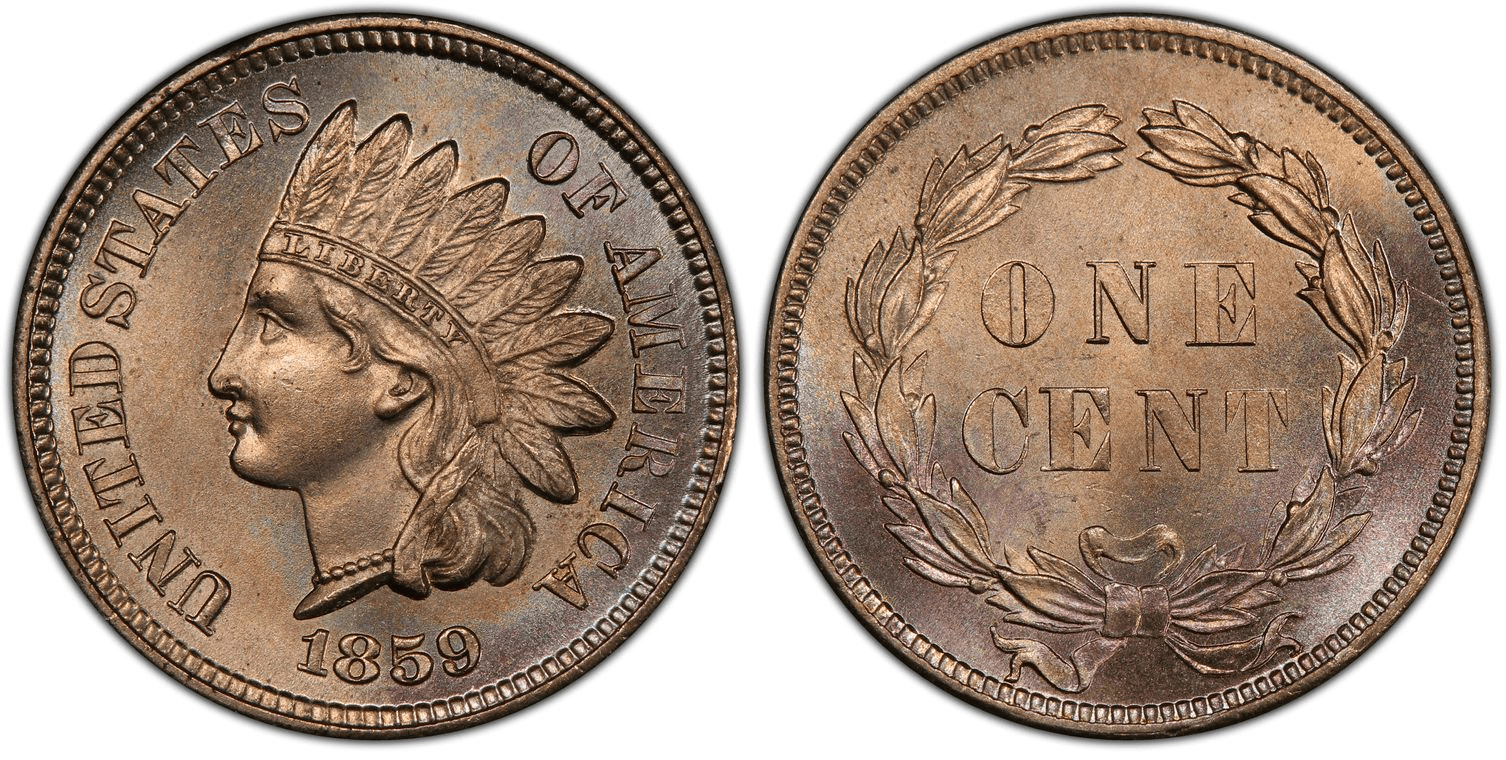
During the American Civil War, demand for nickel increased dramatically to be used in the war efforts. For that reason, nickel prices rose, and people began hoarding copper nickel cents for their intrinsic value. In 1864, The US Congress passed a new Coinage Act, authorizing the production of one-cent coins with a bronze alloy (95% copper and 5% tin and zinc).
The popularity of the Indian Head penny increased wildly in the postwar years. The US Mint would go on to use the design until 1909 when it was replaced by the Lincoln Cent.
What are the most valuable Indian Head Pennies now?
As the coin contains no precious metal content (there are no gold or silver coins from this series), the Indian head penny value derives from its numismatic appeal as a collectible coin and its historical significance rather than its intrinsic value.
First of all, Indian Head pennies, from any mint year, are over 100 years old. It is fair to say that old coins tend to be worth much more than new coins. Therefore, any specimen found, in any condition, that being mint state or even circulated pennies, is bound to draw a coin collector's attention.
However, it is essential to note that the Indian head pennies' worth depends on their appearance and age. So, the better the condition, the better the coin's price. Therefore, a rare Indian Penny in uncirculated condition will reach higher figures, while a circulated one with more prominent wear marks could be found at low prices.
On top of that, the Indian Head design was introduced shortly before the American Civil War. Many numismatists consider the early issues that circulated throughout the war as part of American history.
See a simplified price guide for valuable Indian head pennies below:
Indian Head Penny Value: Price Chart
|
Type |
Condition (MS) |
|||
|---|---|---|---|---|
|
No Shield |
MS 65 |
MS 66 |
MS 67 |
MS68 |
|
1859 |
3,350 |
21,500 |
- |
- |
|
Copper-Nickel |
MS 65 |
MS 66 |
MS 67 |
MS68 |
|
1860 |
1,900 |
4,500 |
55,000 |
- |
|
1860 Pointed Bust |
4,500 |
9,750 |
40,000 |
- |
|
1861 |
1,750 |
4,850 |
27,500 |
- |
|
1862 |
1,600 |
3,850 |
26,500 |
60,000 |
|
1863 |
1,900 |
4,650 |
26,000 |
- |
|
1864 |
1,900 |
4,850 |
37,500 |
- |
|
Bronze |
MS 65 |
MS 66 |
MS 67 |
MS68 |
|
1864 |
1,700 |
7,500 |
35,000 |
- |
|
1864 L on Ribbon |
16,500 |
65,000 |
- |
- |
|
1865 Fancy 5 |
3,800 |
24,000 |
- |
- |
|
1865 Plain 5 |
6,000 |
29,500 |
- |
- |
|
1866 |
5,850 |
17,500 |
- |
- |
|
1867 |
11,500 |
28,500 |
- |
- |
|
1867/67 |
8,500 |
- |
- |
- |
|
1868 |
5,750 |
80,000 |
- |
- |
|
1869 |
7,500 |
85,000 |
- |
- |
|
1870 |
4,750 |
26,000 |
- |
- |
|
1871 |
14,250 |
38,500 |
- |
- |
|
1872 |
17,000 |
55,000 |
- |
- |
|
1873 Open 3 |
7,750 |
16,000 |
- |
- |
|
1873 Closed 3 |
7,150 |
36,000 |
70,000 |
- |
|
1873 Doubled Liberty |
70,000 |
- |
- |
- |
|
1874 |
4,250 |
21,500 |
- |
- |
|
1875 |
5,750 |
12,000 |
- |
- |
|
1876 |
4,250 |
14,000 |
- |
- |
|
1877 |
51,500 |
140,000 |
- |
- |
|
1878 |
3,350 |
17,500 |
- |
- |
|
1879 |
4,000 |
14,000 |
28,500 |
- |
|
1880 |
2,650 |
12,000 |
19,500 |
- |
|
1881 |
2,000 |
9,000 |
25,000 |
- |
|
1882 |
2,000 |
7,750 |
26,000 |
- |
|
1883 |
1,500 |
5,500 |
35,000 |
- |
|
1884 |
2,250 |
8,500 |
25,000 |
- |
|
1885 |
2,350 |
7,750 |
- |
- |
|
1886 Variety 1 |
6,500 |
40,000 |
- |
- |
|
1886 Variety 2 |
17,500 |
25,000 |
- |
- |
|
1887 |
2,850 |
9,500 |
35,000 |
- |
|
1888 |
2,250 |
12,500 |
28,500 |
- |
|
1889 |
3,400 |
15,000 |
- |
- |
|
1890 |
2,500 |
29,500 |
95,000 |
- |
|
1891 |
2,350 |
10,000 |
- |
- |
|
1892 |
2,000 |
5,250 |
28,000 |
- |
|
1893 |
1,400 |
8,500 |
32,000 |
- |
|
1894 |
1,600 |
8,000 |
37,500 |
- |
|
1895 |
1,300 |
4,150 |
25,000 |
- |
|
1896 |
2,150 |
6,000 |
15,500 |
- |
|
1897 |
1,800 |
8,500 |
50,000 |
135,000 |
|
1898 |
925 |
5,000 |
25,000 |
- |
|
1899 |
850 |
2,650 |
30,000 |
125,000 |
|
1900 |
1,000 |
2,750 |
28,500 |
- |
|
1901 |
825 |
2,650 |
33,500 |
- |
|
1902 |
775 |
2,500 |
42,500 |
125,000 |
|
1903 |
875 |
2,500 |
20,000 |
- |
|
1904 |
1,100 |
2,150 |
10,000 |
- |
|
1905 |
750 |
4,000 |
17,000 |
- |
|
1906 |
900 |
3,750 |
24,000 |
- |
|
1907 |
900 |
4,000 |
65,000 |
- |
|
1908 |
850 |
3,500 |
32,500 |
- |
|
1908-S |
4,350 |
9,000 |
27,500 |
- |
|
1909 |
900 |
2,300 |
15,000 |
- |
|
1909-S |
6,850 |
22,000 |
58,500 |
- |
Data from PCGS Price Guide
You can find detailed info about coin prices on PCGS’ price guide, or even in the red book, also known as the Guide Book of United States Coins. Since 1946, it has served collectors as the preeminent annual reference for coin specifications, mintages, values, and photographs.
A Rank of the 11 most valuable Indian Head Pennies, according to PCGS auction records:
The list below contains the 11 most valuable Indian head pennies. Some of them are valuable because they are scarce, but some contain interesting penny errors you should keep an eye out for.
-
1868 Indian Head Cent, MS66+ Red, sold for $72,000.00
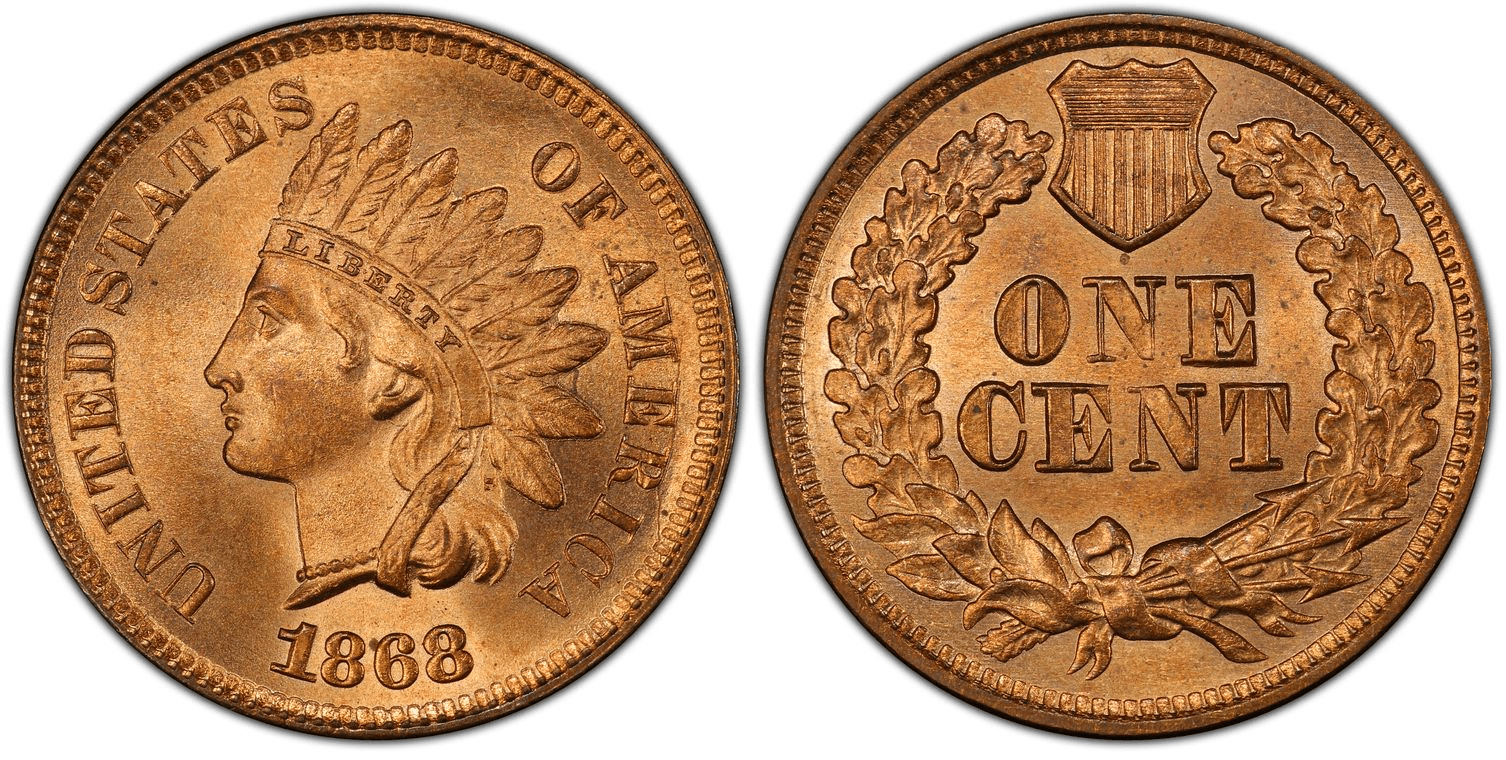
From an original mintage of relatively scarce 10 million coins, fewer than 130 examples of this date have been certified with the Red color designation by PCGS. As you might notice, the scarcest Indian Heads are those produced during the early years.
Many pieces tend to lose their brightness with time, so for this specific issue, the brighter the color, the higher their value will be. Only seven coins from this Philadelphia mint issue have achieved the MS66 rating: four at PCGS and three at NGC. This piece is considered one of the most outstanding business strikes of the 1868 Indian cent series that is known to exist.
In 2019, it was auctioned for $72,000.00.
-
Extremely Rare 1888/7 Indian Head Penny, MS63 Brown, sold for $74,750.00

Many numismatists believe that the master hub for the 1887 cent was used to mint the 1888 issue. That is because a lump of the number “7” is visible on top and on the bottom of the number “8”, the last digit of the mint year.
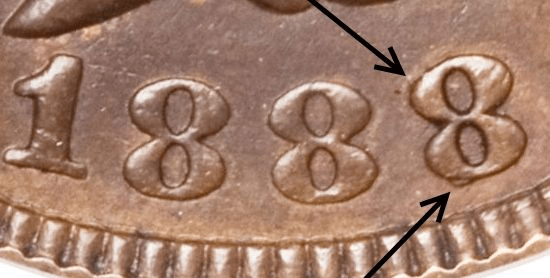
1888 with 8 over 7
Only 30 examples are known today and are all almost well circulated. This coin is Considered by specialists one of the most important numismatic discoveries of the decade, and it was even published in the April 1970 issue of The Numismatist.
In 2007, it was sold for $74,750.00 at Heritage Auctions.
-
1869 Indian Cent, MS66+, sold for $84,000.00
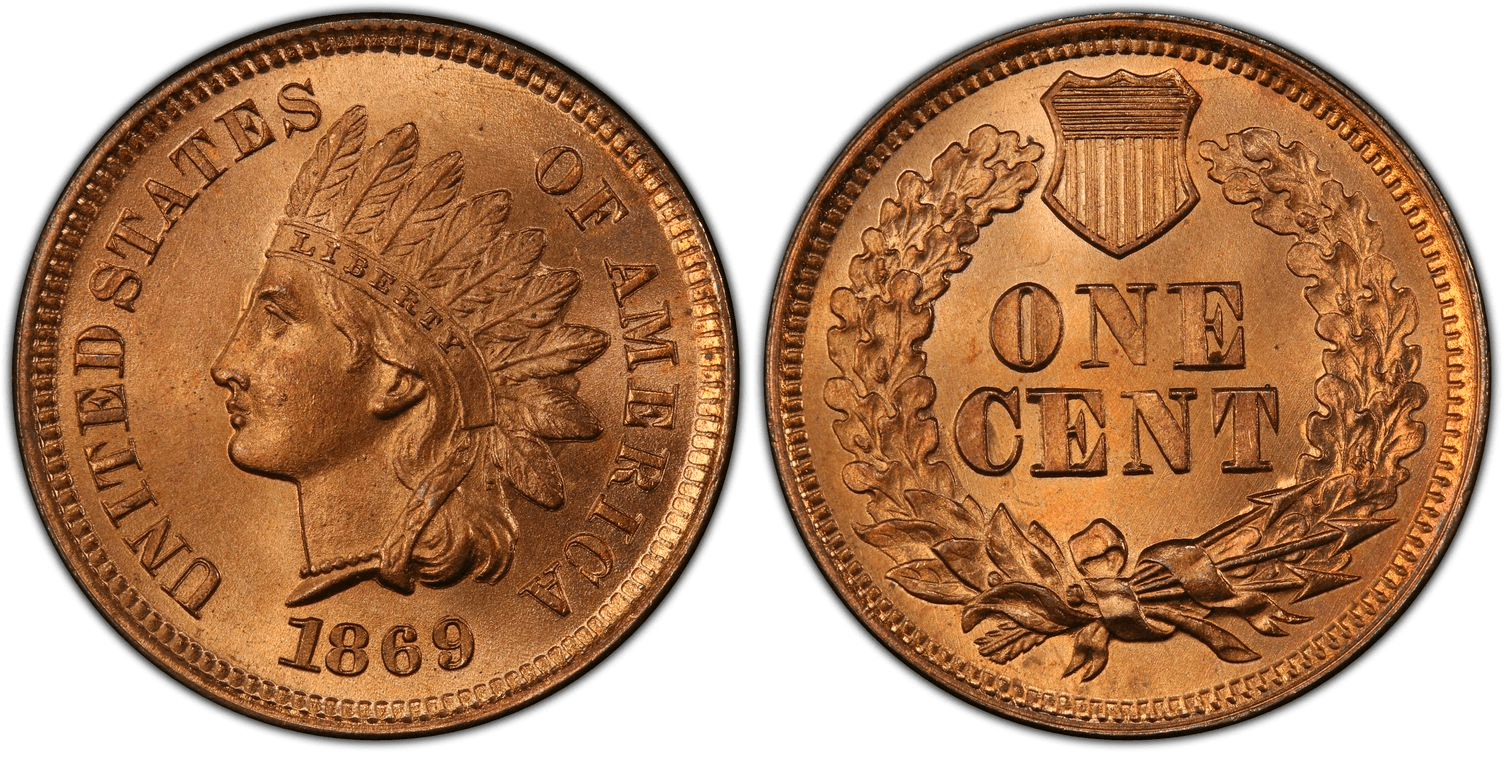
Considered to be very hard to find in any grade, a mistake in the Mint Act of April 22, 1864, led to the large-scale melting of small cents and two-cent pieces in the late 1860s.
Because the act provided no redemption clause for those denominations and the legal tender limit for the cent was only 10 cents, bank institutions would refuse to accept large deposits of cents and two-cent pieces from merchants.
The merchants would then turn the coins in at the Mint to be melted and recoined. More than 55 million bronze cents were melted for the next 10 years. The availability of the 1869 cent, with an already considerably small mintage of 6.4 million pieces, was reduced even more because of this.
In 2019, the piece illustrated above was sold for 84,000.00 at Heritage Auctions.
-
1890 Indian Head Penny MS67+ sold for $91,062.50
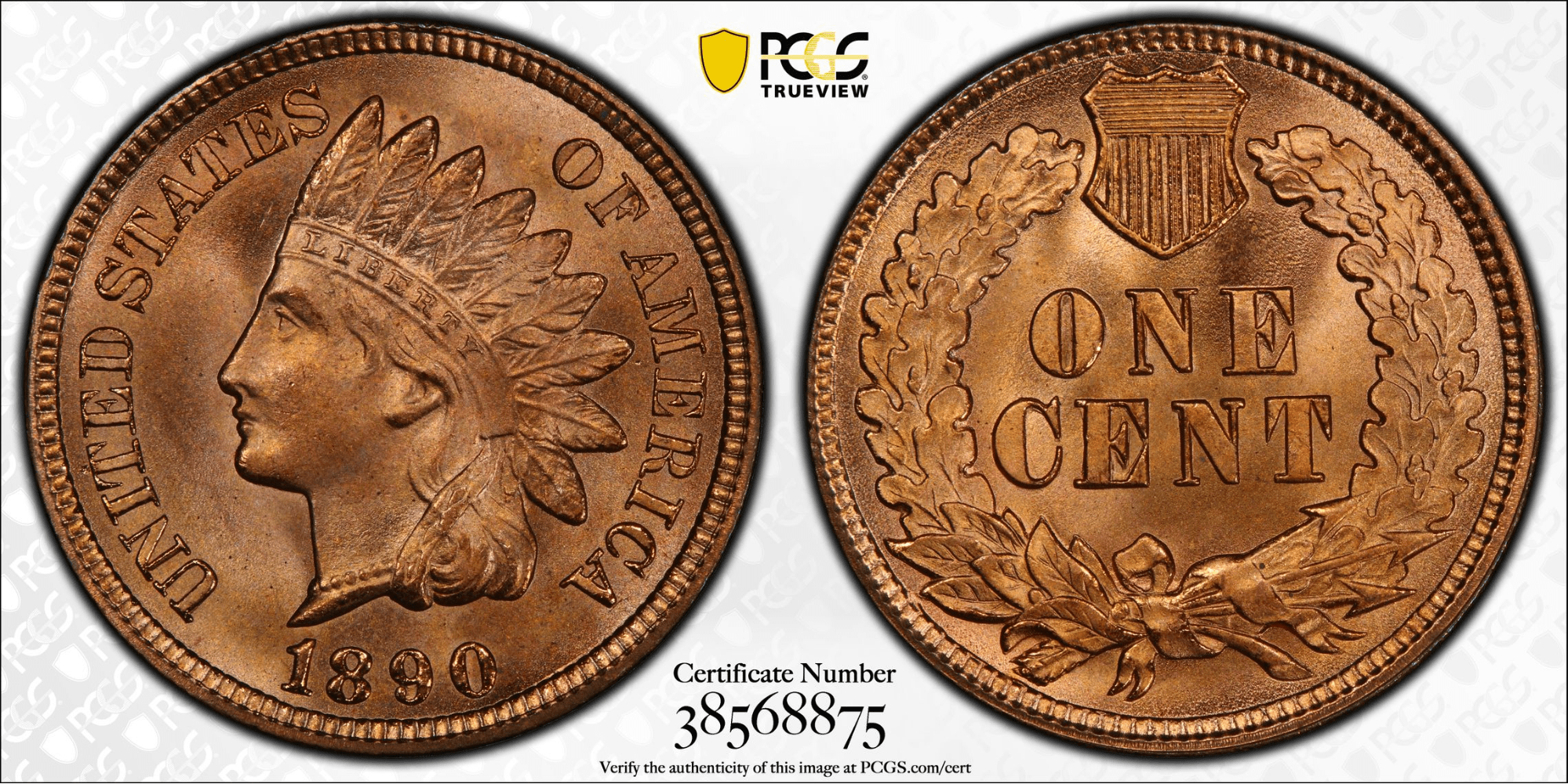
With a perfect surface, specialists affirm that this is one of the finest Indian Head cents that survives in the entire 50-year series. The surfaces are nearly impeccable. Only a couple of dozen examples across the entire series grade MS67 RD and even fewer of these grade MS67+. According to specialists, this specimen is worthy of a world record.
An 1890 PCGS MS67+ Indian Head Penny was sold for $91,062.50 in 2020.
-
1909-S Indian Cent MS67 sold for $97,750.00

The year 1909 marked the last mintage of the Indian Head Cent Series. A little less than 14,800,000 were minted that year. As it is the series' final issue, it is only natural that collectors would be immensely drawn to it. But that is especially true for the specimens struck in the San Francisco Mint.
Only 309,000 Indian Head cents were minted with the San Francisco mint marks, and a few of them have survived the 20th century.
A bidder purchased one MS67 specimen for $97,750 in 2006.
-
1899 Indian Cent, MS68, sold for $108,000.00
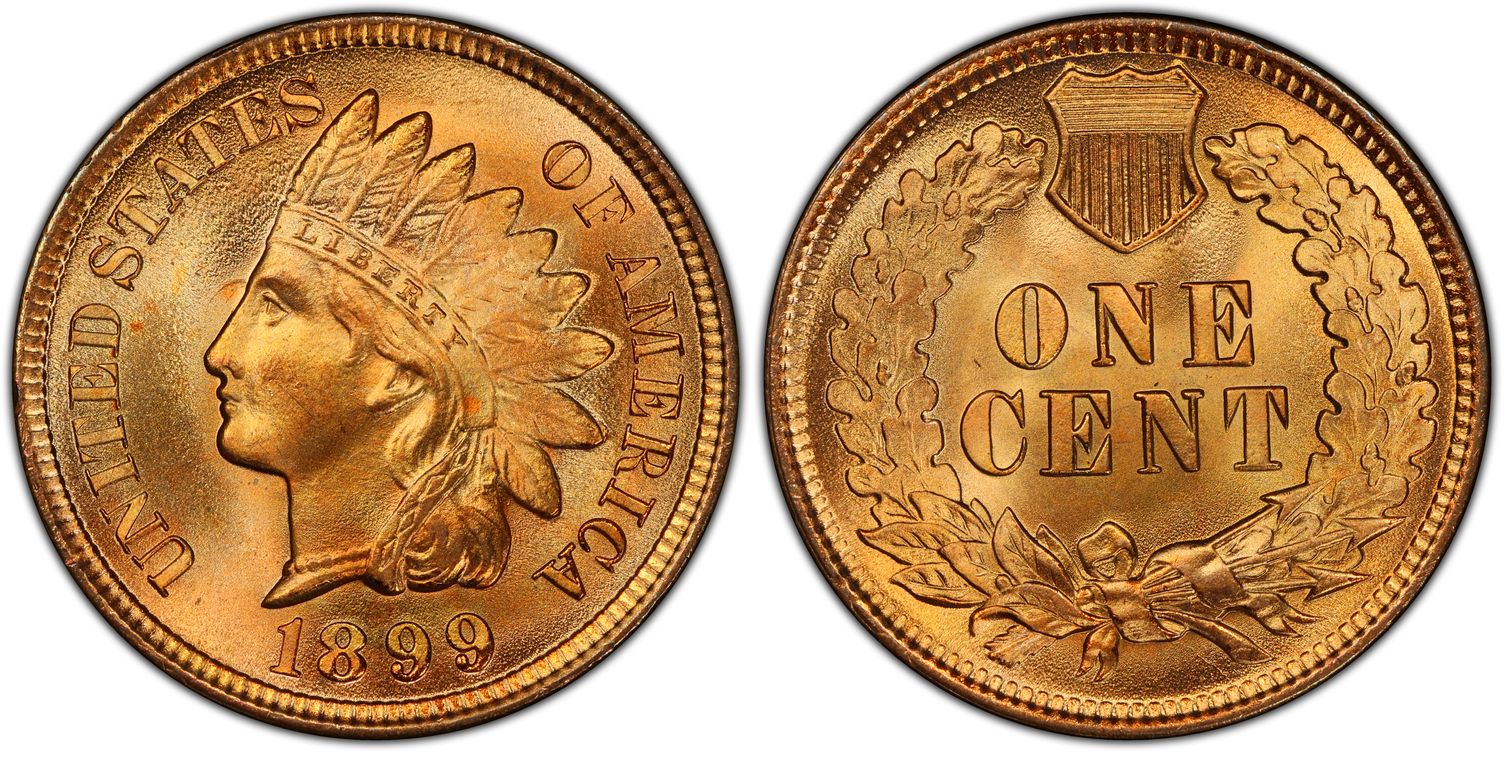
Amongst all the hundreds of millions of bronze Indian cents struck between 1864 until the end of the series in 1909, this example stands alone as the finest survivor of the type. These bronze Indian cents are really rare to find at the MS68 Red level. Both sides are, in fact, blemish-free with a beautiful mint luster.
In 2019, an 1899 Indian Cent, MS68, was sold for $108,000.00.
-
1897 Indian Cent. Proof-67+ sold for $108,000
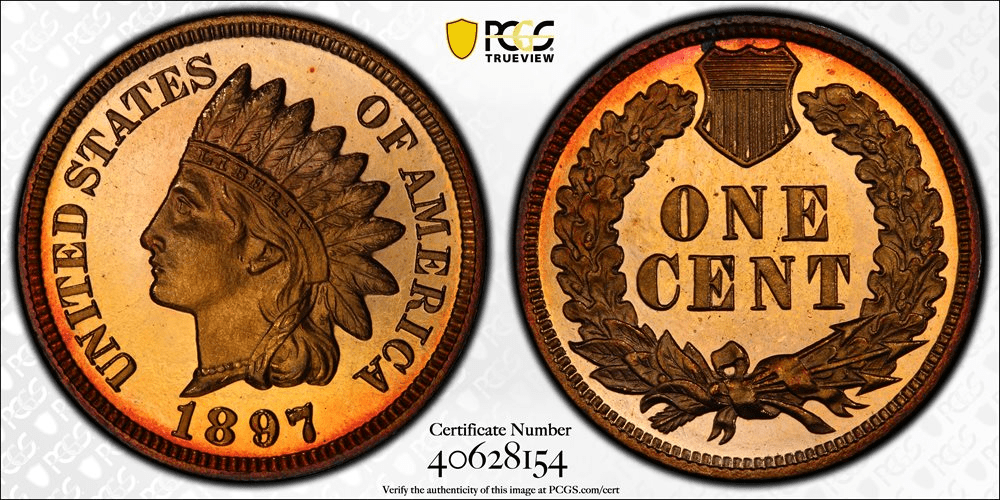
The Proof 1897 Indian head penny is an underrated rarity among the late dates from the series. With a small mintage of 1,938 Proofs, the 1897 cent is most likely to be found in grades of Proof 64 or lower, with many having been cleaned, polished, or mishandled over the past century. Gem examples are only sold at auctions a couple of times per year, though those with any traces of Cameo contrast are extremely rare.
In 2019, this 1897 Indian Cent Proof-67+ was sold for $108,000.
-
1872 MS66 Indian Head Penny sold for $126,500.00

This is also one of the toughest dates to find nowadays. Most coins of this issue are streaky because of the uneven alloy mixes. Some of them were poorly struck or are missing details due to some liquid, like machine oil, getting mixed in the planchets or dies. For that reason, finding attractive, problem-free examples can be really challenging.
In 2007, an 1872 MS66 Indian Head Penny was sold for $126,500.00.
-
1902 Indian Cent MS-68 sold for $144,000.00
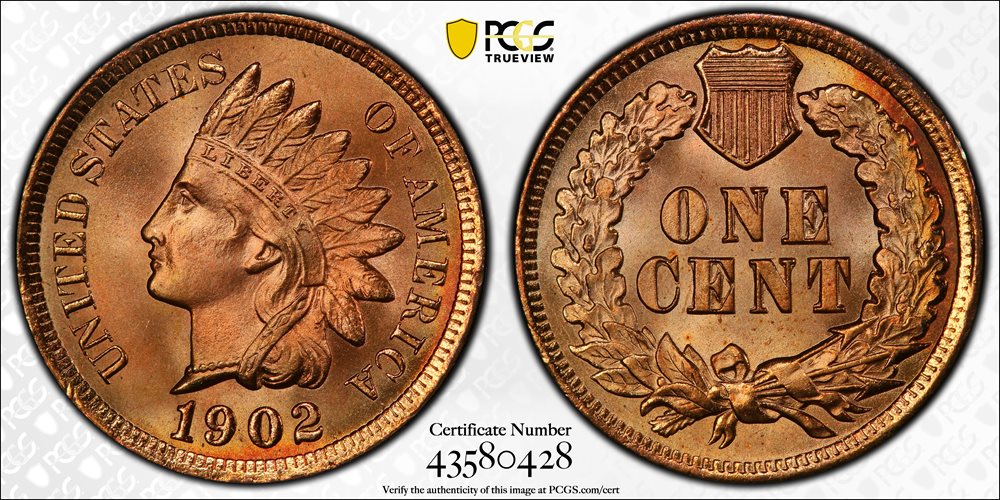
With great condition and a very sharp strike, there are only two individuals of this coin to exist, according to PCGS records. These coins are very scarce to be found in good condition, and superb gems such as this one tend to appear on auctions only once in a while. Which can explain the high price.
In 2022, the 1902 Indian Head Cent MS68 illustrated was sold for $144,000.00.
-
1877 Indian Head Penny MS66 sold for $149,500.00
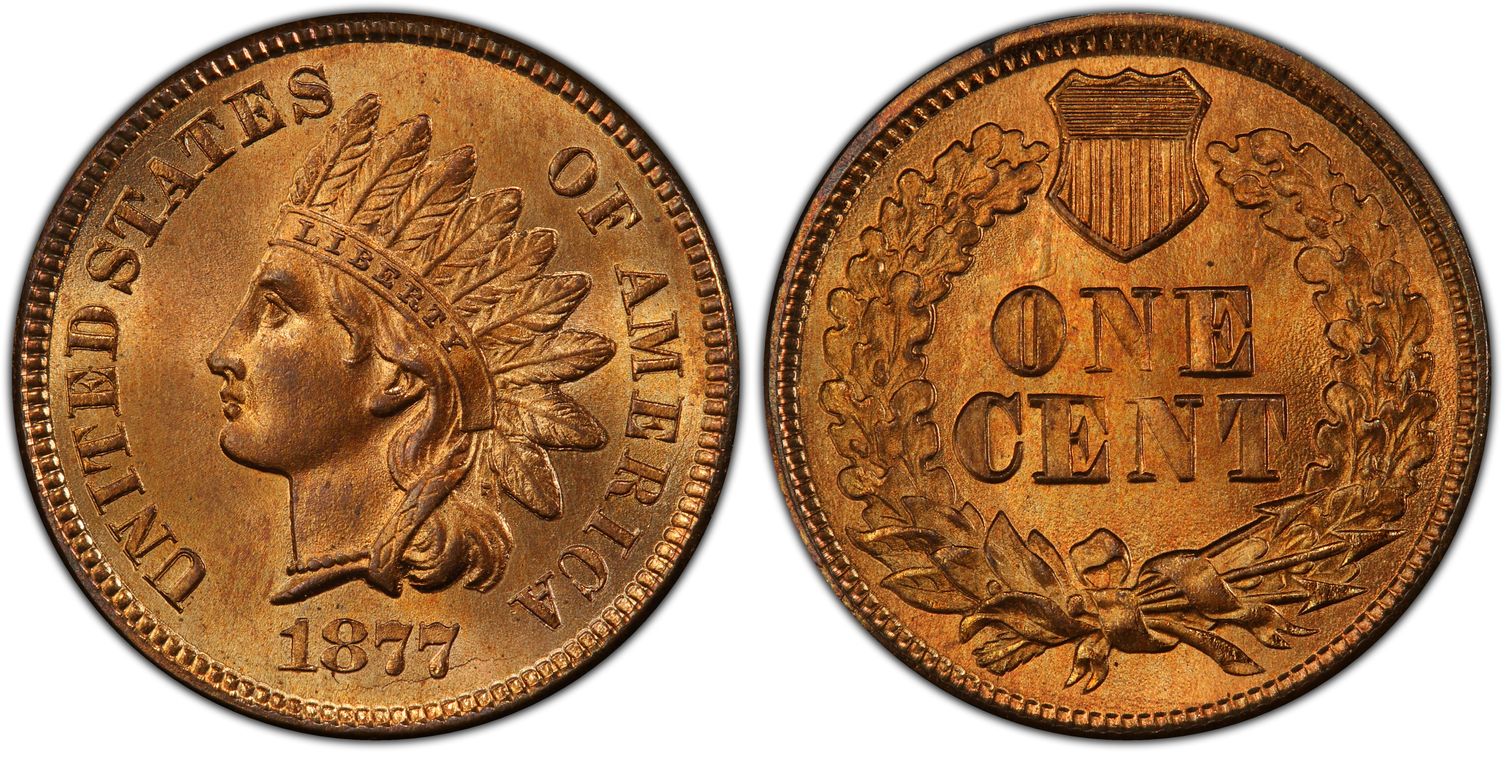
This issue is arguably the rarest of the Indian Head cents. The reason is that, at the time, the country was going through a poor economy, which caused a small demand for cents. Therefore, only 852,500 were minted that year. That is, by far, the lowest mintage in the whole series.
An MS66 specimen was sold in 2007 for an impressive $149,500.
-
1864 L On Ribbon PR65 Indian Head Penny was sold for $161,000.00
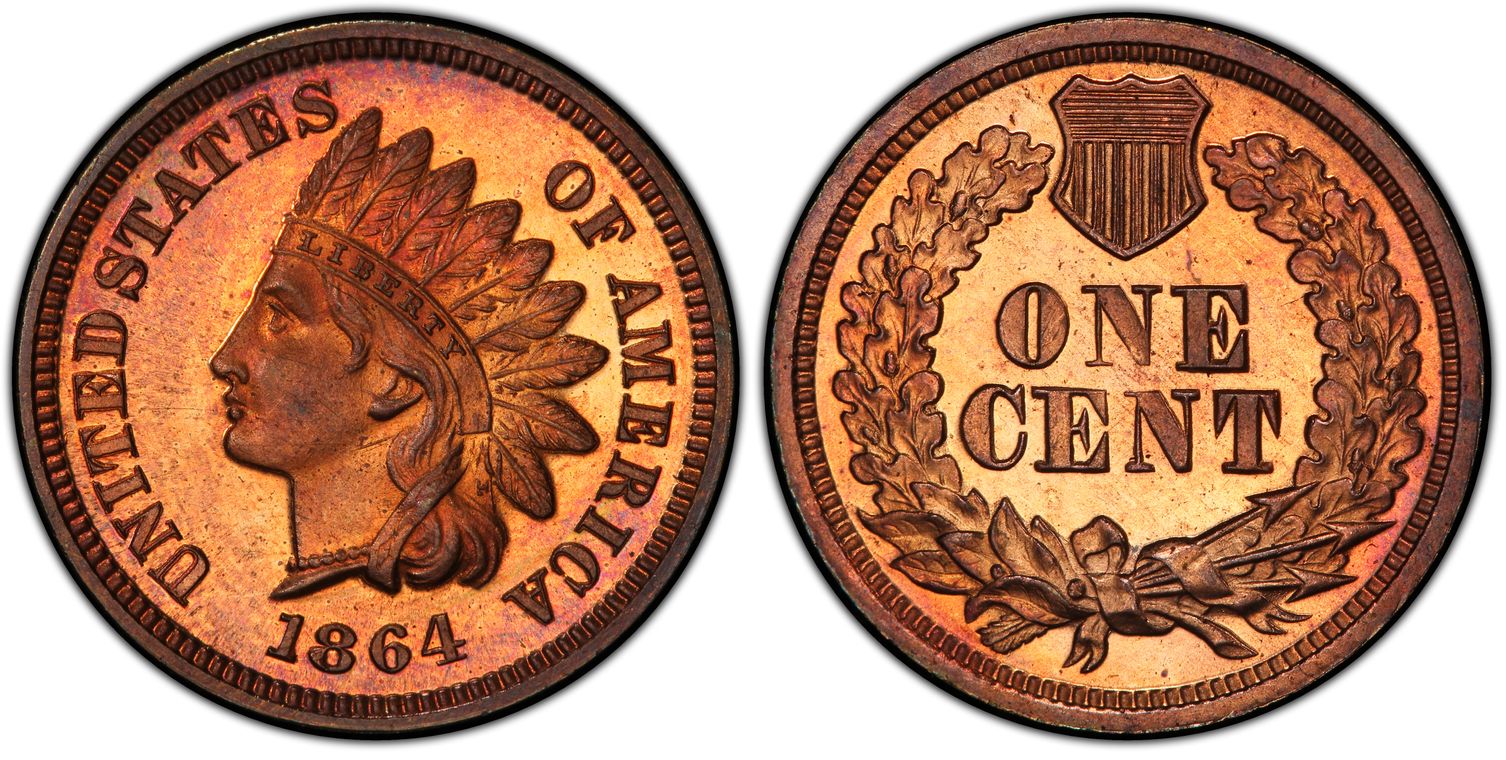
Another example of the key dates, near the end of 1864, the first year of the bronze Indian cents, the portrait of the Indian was sharpened, and the designer's initial L for James Longacre was placed on the ribbon behind the neck.
With an estimated mintage of only 20 pieces, Its proof version is a legendary rarity and hardly exchanges owners. And whenever they do come to market, they tend to set records.
As proof, in 2011, the Indian head penny shown above was auctioned for $161,000.00.
Final Thoughts
This article has covered the most valuable Indian Head pennies, but there are many more valuable pennies from other varieties.
If you are lucky to come across one of these Indian head penny rare finds, take it to your trusted coin dealer or coin authenticator to ensure it is the real thing and not a counterfeit. You can reach out to trusted grading professionals at the American Numismatic Association. You might have found yourself a pot of gold coins.
















